4-6. Could the creator of the glyph text possibly have hinted at the idea
of bissextum where Procyon culminated at 21h in the day
after Castor would have culminated at 21h?
|
Febr 22 |
23 (→
Terminalia) |
 |
 |
|
Ea4-2 |
Ea4-3 |
|
marama |
tagata moe - marama |
CASTOR (α Gemini) |
PROCYON (α Canis Minoris) |
A quick look at the
corresponding glyphs in the earlier sequences at first
appears to negate this idea, because similar patterns are
depicted in all 10 prior sequences. However, there is a
difference, because the object in front in the day of
Terminalia is not the same as in all the earlier
examples. This shape is quite irregular and more flattened. More
like that at Almaaz
(Ea1-19) and that at Ea1-10 (Ain). Such small
differences carry meaning.
In the following day the Sun rose together with Homan
(*341.2), with the Full Moon (ideally) at the right
ascension line of the 4th Son behind the King - Possessing
Luminous Rays (Shir, *158.9).
"Homam seems to have been first given to this in the
Palermo Catalogue, from Sa'd¹
al Humām, the Lucky Star of
the Hero, in which Ulug Beg included ξ; other lists have
Homan.
¹ This Arabic Sa'd is our 'Good
Luck' and a component word of many titles in the Desert sky,
all of which seem to have been applied to stars rising in
the morning twilight at the commencement of the pleasant
season of spring. Al Sa'dain, the dual
form, was the title for Jupiter and Venus, the Two Fortunate
Planets; Al Nahsān, the Unlucky, referring to Mars
and Saturn.
But Hyde said that the original
was Al Hammām,
the Whisperer.
Al Tizini mentioned it as
Sa'd Al Na'amah,
the Lucky Star of the Ostriches; and Al Achsasi,
Al Nā'ir Sa'd al Bahāim,
The Bright Fortunate One of the Two Beasts, which Al Sufi
had said were θ and ν. Thus ξ was one of the general
group Al Su'ūd al Nujūm,
the Fortunate Stars.
The Chinese called it
Luy Tien, Thunder."
(Allen)
Hevelius has indicated the
position of the star ζ Pegasi
to be at the throat of the truncated upside down flying Pegasus Horse.
Was this creature
possibly corresponding to the spirit of the Bird of Thunder? I.e. to
the Ghost of Jupiter (NGC3242 Hydrae, *156.8) two
days befor Shir.
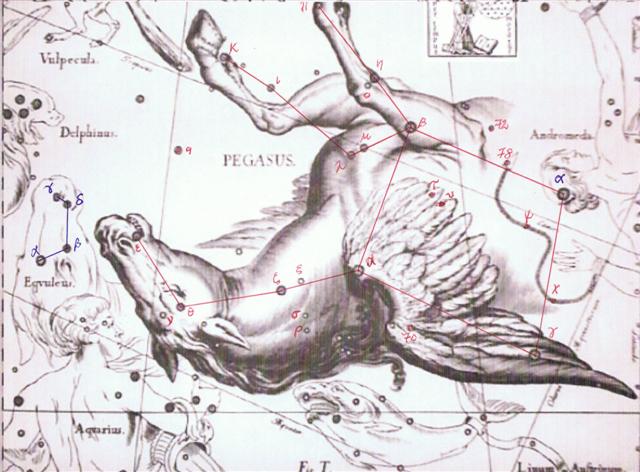
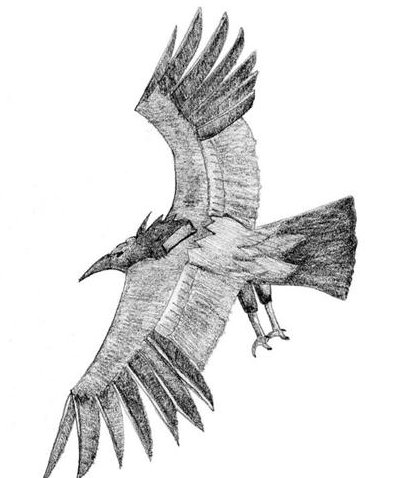
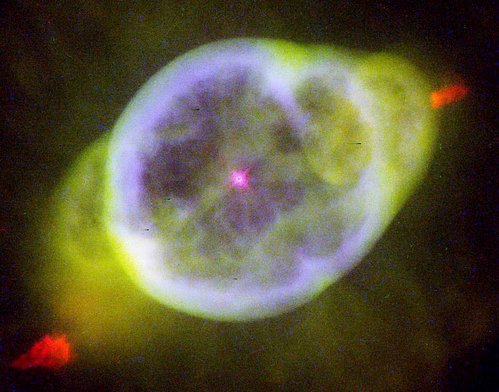
|
Febr 22 |
23 (→
Terminalia) |
24 (420) |
25 (136 - 80) |
26 |
27 |
|
→
INVISIBLY CLOSE TO THE SUN: |
|
Al Sa'ad al Ahbiyah-23
(Lucky Star of Hidden Things)
/
Shatabisha-25
(Comprising a Hundred Physicians)
ε
Oct. (338.1),
ρ
Aquarii
(338.2), 2/365 Lac. (338.5),
SADACHBIA =
γ
Aquarii
(338.6),
π
Gruis (338.9) |
β/172
Lac. (339.2),
4/1100 Lac. (339.4),
π
Aquarii
(339.5)
*298.0 = *339.4 - *41.4
CASTOR (α Gemini) |
δ Tucanae (340.1), ρ Cephei (340.2), ν Gruis
(340.3),
ζ Aquarii, δ Gruis (340.4), 5/1100 Lac. (340.7), σ Aquarii, 6/650 Lac. (340.9)
*299.0 = *340.4 - *41.4
PROCYON (α Canis Minoris) |
υ
Oct. (341.0), α/91 Lac. (341.1),
HOMAN = ζ
Pegasi,
β Piscis Austrini (341.2), ν Tucanae (341.5), υ
Aquarii (341.9) |
η Aquarii (342.1), σ Gruis (342.4),
SITULA (Water-jar) = κ Aquarii
(342.7)
*301.0 = *342.4 - *41.4 |
ε
Piscis Austrini (343.5), ο Pegasi, β Gruis
(343.8) |
|
... γ,
4.1, greenish, on the right arm at the inner
edge of the Urn, and the westernmost star in the
Y, is Sadachbia, from Al Sa'd al
Ahbiyah, which has been interpreted the
Lucky Star of Hidden Things or Hiding-places,
because when it emerged from the sun's rays all
hidden worms and reptiles, buried during the
preceding cold, creep out of their holes! But as
this word Ah Biyah is merely the plural
of Hibā', a Tent, a more reasonable
explanation is that the star was so called from
its rising in the
spring twilight, when, after the winter's want
and suffering, the nomads' tents were raised on
the freshening pastures, and the pleasent
weather set in. This
idea renders Professor Whitney's 'Felicity of
Tents' a happy translation of the original ...
... Zeta
(uppercase Ζ,
lowercase ζ; Greek:
ζήτα
... is the sixth letter of the Greek alphabet.
In the system of Greek numerals, it has a value
of 7. It was derived from the Phoenician letter
Zayin. Letters that arose from zeta
include the Roman Z and Cyrillic З
...Zayin
(also spelled Zain or Zayn or
simply Zay) is the seventh letter of many
Semitic abjads ... It represents the sound
[z]. The Phoenician
letter appears to be named after a sword or
other weapon. (In Biblical Hebrew, 'Zayin'
means sword, and the verb 'Lezayen' means
to arm. In modern Hebrew, 'zayin' means
penis and 'lezayen' is a vulgar term
which generally means to perform sexual
intercourse and is used in a similar fashion to
the English word fuck, although the older
meaning survives in 'maavak mezuyan'
(armed struggle) and 'beton mezuyan'
(armed, i.e., reinforced concrete). The
Proto-Sinaitic glyph according to Brian Colless
may have been called ziqq, based on a
hieroglyph depicting a 'manacle' ...

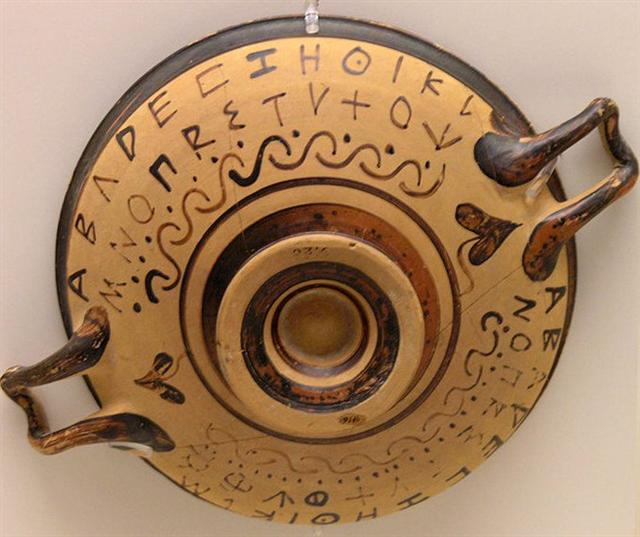
... Kaph is thought to have been derived
from a pictogram of a hand (in both modern
Arabic and modern Hebrew, kaph means
palm/grip) ... The manik,
with the tzab, or serpent's rattles as
prefix, runs across Madrid tz. 22 , the figures
in the pictures all holding the rattle; it runs
across the hunting scenes of Madrid tz. 61, 62,
and finally appears in all four clauses of tz.
175, the so-called 'baptism' tzolkin. It seems
impossible, with all this, to avoid assigning
the value of grasping or receiving. But in the
final confirmation, we have the direct evidence
of the signs for East and West. For the East we
have the glyph Ahau-Kin, the Lord Sun,
the Lord of Day; for the West we have
Manik-Kin, exactly corresponding to the term
Chikin, the biting or eating of the Sun,
seizing it in the mouth.



The pictures (from Gates) show
east, north, west, and south; respectively (the
lower two glyphs) 'Lord' (Ahau) and
'grasp' (Manik). Manik was the 7th
day sign of the 20 and Ahau the last ... |
 |
 |
 |
 |
 |
 |
|
Ea4-1 →
Bharani |
Ea4-2 |
Ea4-3 |
Ea4-4 (104) |
Ea4-5 |
Ea4-6 |
|
Tagata moe |
marama |
tagata moe - marama |
kua
oho - vai taketake |
te
hokohuki - moa ia |
hokohuki |
|
Take. The Marquesans are the only
people who own to a distinctive national name,
and retain a tradition of the road they
travelled from their original habitat, until
they arrived at the Marquesan Islands. They call
themselves te Take, 'the Take
nation'. Fornander. Take, Tuvaluan for
the Black Noddy (Anous Minutes). The
specific epithet taketake is Māori for
long established, ancient, or original. In the
Rapa Nui mythology, the deity
Make-make was the chief god of the birdman
cult, the other three gods associated with it
being Hawa-tuu-take-take (the Chief of
the eggs) his wife Vie Hoa and Vie
Kanatea. Wikipedia.
... When it was evident that
the years lay ready to burst into life, everyone
took hold of them, so that once more would start
forth - once again - another (period of)
fifty-two years. Then
(the two cycles) might proceed to reach one
hundred and four years. It was called 'One Age'
when twice they had made the round, when twice
the times of binding the years had come
together. Behold what was done when the years
were bound - when was reached the time when they
were to draw the new fire, when now its count
was accomplished. First they put out fires
everywhere in the country round. And the
statues, hewn in either wood or stone, kept in
each man's home and regarded as gods, were all
cast into the water.
Also (were) these (cast away) - the pestles and
the (three) hearth stones (upon which the
cooking pots rested); and everywhere there was
much sweeping - there was sweeping very clear.
Rubbish was thrown out; none lay in any of the
houses
...
... In the
present context 'mouth' has an additional
connotation, given that it refers in part to
Heart of Earth, the deity called 'Mundo'
today. This is the great Mesoamerican earth
deity, the ultimate swallower of all living
beings, depicted in Classic Mayan art (in the
Palenque relief panels, for example) as an
enormous pair of jaws upon whose lips even the
feet of great lords must rest in precarious
balance, and into whose throat even great lords
must fall. Turning to the contemporary scene,
daykeepers who visit the main cave beneath the
ruins of Rotten Cane,
the last Quiché capital, speak of the danger of
falling into 'the open mouth of the Mundo'
there, which is said to be more than four yards
wide
...
... A crack
opened up in the ground, and the Rat was put
down into the pit, to rest there - he
hakatopa i te kioe.ki raro ki te rua.he hakarere
... [E:
Tori 4]
...
Interestingly, since another meaning of shi
is 'death', the number 4 is considered unlucky.
For example, the floor numbering in
hotels sometimes jumps
mysteriously from 3 to 5; it's also considered
unlucky to give four of something as a present
...
|
Counting the tresses from
right to left: |
|
1 |
26 |
78 |
1 |
29 |
90 |
|
2 |
26 |
2 |
30 |
|
3 |
26 |
3 |
31 |
|
4 |
25 |
104 |
4 |
34 |
124 |
|
5 |
26 |
5 |
31 |
|
6 |
27 |
6 |
30 |
|
7 |
26 |
7 |
29 |
|
Total = 182 + 214 = 396
|
|
|
VISIBLE
CLOSE TO THE FULL MOON: |
|
ALGIEBA (The Mane) =
γ
Leonis,
q Carinae (155.5) |
TANIA AUSTRALIS (Southern Gazelle) =
μ
Ursae Majoris
(156.0),
GHOST OF JUPITER = NGC3242 Hydrae
(156.8) |
Extended Net-26b (Ox)
μ
Hydrae
(157.1) |
Maru-sha-arkat-Sharru-15 (4th Son behind the
King)
SHIR (Possessing Luminous Rays) =
ρ
Leonis
(158.9) |
p Carinae (159.3) |
φ Hydrae (160.3) |
|
ALCYONE (136) |
*100 |
TANIA AUSTRALIS (236) |
|
May 16 (*56) |
Aug 24 (*156) |
|
σ Virginis (280 = 136 + 64 + 80) |
*100 |
ALTAIR (380 = 136 + 236 + 8) |
|
AUG 4 (*136) |
NOV 12 (*236) |
|
... It was 4 August 1968, and it was the feast day of Saint
Dominic, patron of Santo Domingo Pueblo, southwest of Santa Fe.
At one end of the hot, dusty plaza, a Dominican priest watched
nervously as several hundred dancers arranged in two long rows
pounded the earth with their moccasined feet as a mighty,
collective prayer [ui] for rain, accompanied by the
powerful baritone singing of a chorus and the beat of drums. As
my family and I viewed this, the largest and in some ways the
most impressive Native American public ceremony, a tiny cloud
over the Jémez Mountains to the northwest got larger and larger,
eventually filling up the sky; at last the storm broke, and the
sky was crisscrossed by lightning and the pueblo resounded with
peals of rolling thunder ... |
|
|
Aug 23 (235) |
24 (8 * 29½) |
25 (420 - 183) |
26 |
27 |
28 (240) |
In this
our multifaceted discussion it should be added that among the many Polynesian
names of Jupiter there was
Homan-alonalo, Jupiter (Father Light, Jus-piter) as morning star:
Aro.
Face, front, side (of a figure); ki te aro o ..., to the front of ...
Vanaga. Presence, body, frontispiece; ki te aro, face to face. P
Pau.: aroga, the visage; ki te aroga, opposite. Mgv.: aro,
presence, before; i te aro, in the presence of. Mq.: aó, face,
in the presence of, before. Ta.: aro, face, front, presence, view. It
is probable that more than one word is confounded in alo. The
significations which appear in Southeast Polynesia are most likely derived
from a Tongafiti alo and do not appear in Nuclear Polynesia. The
alo belly and alo chief which do occur in Nuclear Polynesia are
also probably Tongafiti, for in Samoa and Tonga they are honorific and
applied only to folk of rank, a good indication of borrowing by the
Proto-Samoans from Tongafiti masters. Churchill. In the Hawaiian group, the
western portion or side of an island was called 'the front', ke alo,
of the land, and the eastern side was called 'the back', ke kua. The
reason of such designations must be sought in the fact of the arrival of the
inhabitants from the west. Fornander.
Rona
Figure made of wood, or stone, or painted, representing a bird, a
birdman, a lizard, etc. Vanaga. Drawing, traction. Pau.: ronarona, to
pull one another about. Churchill. While the rongorongo signs (rona)
are generally 'carved out, incised' (motu), ta implies an
incision ('cutting, beating') as well as the process of applying signs to
the surface with the aid of a dye ... RAP. rona means primarily
'sign' (an individual sign in the Rongorongo script or a painted or carved
sign made on a firm background, such as a petroglyph), but also 'sculpture'
(made from wood or stone, representing animals of hybrid creatures) ...
rona (lona) implies the idea of 'maintaining a straight line'
with ropes and nets and also the maintaining of a steady course (in MAO. and
TUA.). Te Rona is the name of a star in TUA., which Makemson
(1941:251) derives from the mythical figure of 'Rona', who is
connected with the moon and is considered to be the father of (the moon
goddess) Hina (for this role in MAO., see Tregear 1891:423). From
west Polynesia come totally different meanings. Interesting perhaps is FIJ.
lona, 'to wonder what one is to eat, fasting for the dead.' ...
Barthel 2
|
POLYNESIAN NAMES FOR
JUPITER: |
|
Hawaiian Islands |
Society Islands |
Tuamotus |
|
Ikaika
(brilliant).
Ikiiki
(a goddess, a Hawaiian month name and therefore probably a fixed
star rather than a planet)
Kaawela
or Kawela ('Burning'). Homanalonalo. Iao
('Of-the-dawn', Jupiter as morning star) |
Ta'urua-of-the-confusion-in-the-sky-with-Hawaii-in-the-rear.
Ta'urua-who-struck-the-zenith-of-the-sky
Ta'urua-who-rises-in-the-path-of-the-rainbow |
Poro-hutu
('Round Hutu' - the name of a tree. The planet was described
as 'distinctly yellow in color and slow in movement') |
|
New
Zealand |
Marquesas |
Pukapuka |
|
Kopu-nui
('Great-paunch'; also given to Saturn. Apparently Jupiter and Saturn
were often confused.
The
attendants of the royal temple at Tahiti were known as (k)opu-nui,
indicating that the word had a sacred significance.)
Rangawhenua (see Mars) |
Hua
('Fruit' or 'Egg'; also universally the name for the full Moon.) |
Tapao
('Hammer' or 'Mallet'; as a morning star)
Tokiva
('Axe-of-space'; when overhead)
Tu-la-lupe
('Day-folded-together'; as evening star)
|
Ao. Large dance paddle. 1.
Command, power, mandate, reign: tagata ao, person in power, in
command, ruler. 2. Dusk, nightfall. 3. Ao nui, midnight. 4. Ao
popohaga, the hours between midnight and dawn. Aô, to serve
(food); ku-âo-á te kai i ruga i te kokohu, the food is served on a
platter. Vanaga. 1. Authority, kingdom, dignity, government, reign (aho);
topa kia ia te ao, reign; hakatopa ki te ao, to confer rank;
ao ariki, royalty; ka tu tokoe aho, thy kingdom come. PS Mgv.:
ao, government, reign. Mq.: ao, government, reign, command.
Sa.: ao, a title of chiefly dignity; aoao, excellent,
surpassing, supreme. 2. Spoon; ao oone, shovel. 3. Dancing club T. 3.
Aonui (ao-nui 2), midnight. 4. Pau.: ao, the world.
Mgv.: ao, id. Ta.: ao, id. Mq.: aomaama, id. Ma.: ao,
id. 5. Pau.: ao, happy, prosperity. Mgv.: ao, tranquil
conscience. Ta.: ao, happiness. 6. Mgv.: ao, cloud, mist. Ta.:
ao, id. Mq.: ao, id. Sa.: ao, cloud. Ma.: ao,
id. 7. Mgv.: ao, hibiscus. 8. Ta.: ao, day. Mq.: ao,
day from dawn to dark. Sa.: ao, id. Ma.: ao, id. 9. Ta.: ao,
a bird. Ha.: ao, id. 10. Mq.: ao, respiration, breath. Ha.:
aho, breath. 11. Mq.: ao, to collect with hand or net. Sa.: ao,
to gather. Ma.: ao, to collect. Ta.: aoaia, to collect food
and other things with care. Churchill.
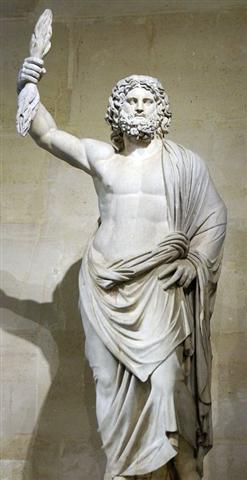
|










